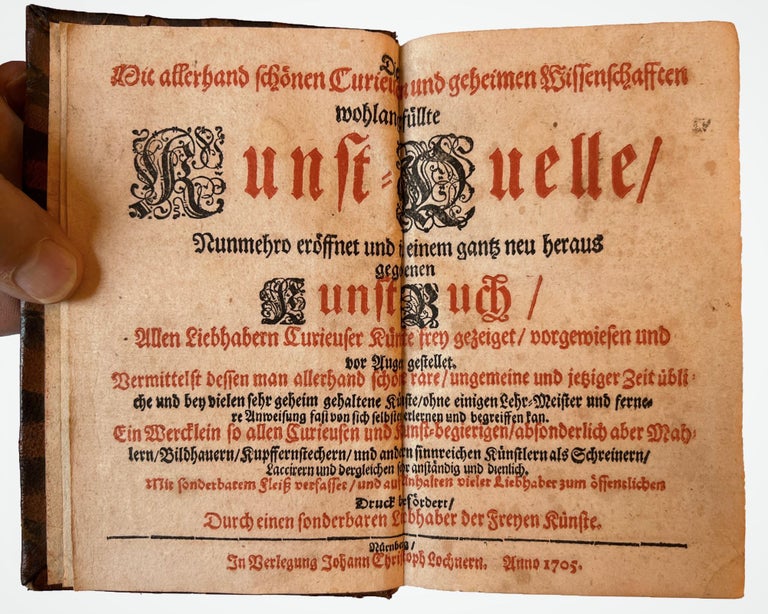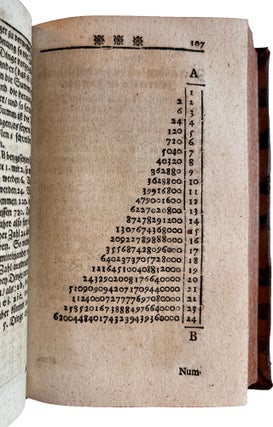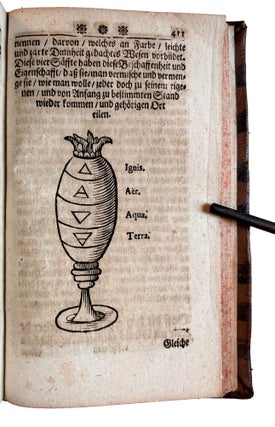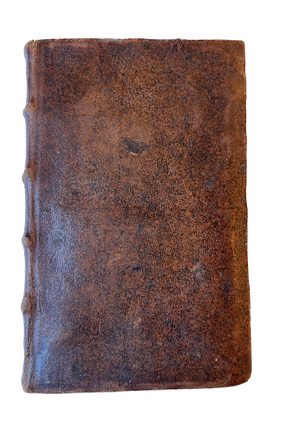Die Mit allerhand schönen Curieusen und geheimen Wissenschafften wohlangefüllte Kunst-Quelle ... Durch einen sonderbaren Liebhaber der Freyen Künste. Nuremberg: Johann Christoph Lochner, 1705.
8vo (163 x 98 mm). [4] ff., 464 pp. Double-page title printed in red and black, woodcut tailpiece, one woodcut figure, several numerical or alphabetic diagrams including a full-page table of polynomials. Some light paper spotting due to paper quality, short tear to a leaf (pp. 365-6), but a nice copy. Contemporary speckled sheep, edges red-sprinkled. ***
Only Edition, very scarce, of a truly encyclopedic manual for artists and craftsmen, as well as for scribes, spies, lovers, dabblers, cleaners, wannabe swimmers ... or anyone looking for Something to Do.
Part I is on the arts of writing. It opens with recipes for various inks, including an ink that will last while traveling; instructions for teaching someone to write in one hour (only possible with the Roman alphabet because it consists of straight lines and semi-circles), writing for the blind, writing in the dark, and disappearing inks. This leads into the arts of secret messages, treating numerical and alphabetical codes, communicating at a distance with handkerchiefs (each letter being represented by a number), and various other cryptographic and steganographic schemes, using letters, entire words, or mirror writing; the hiding of messages in wooden rods or eggs; writing in white ink, which disappears until ready to be revealed, on black paper, white paper or parchment; fireproof writing, self-destroying paper, secret messages on handkerchiefs and playing cards, and many other methods of surreptitious communication. Moving from one extreme to the other, the author next treats display writing: writing in fiery letters, in water, in gold or silver on black tablets or regular paper, and in indelible chalk. He occasionally cites earlier works, including Schwenter’s and Harsdörffer’s Mathematische Erquickstunden (1636-1653), and Kircher’s “Geheimnissen” (?).
In the middle of this section the author abruptly switches topics, presenting a series of guessing games (pp. 63-107) involving numbers, letters, ring fingers, guessing what another is thinking of, and so on, all based on statistical analyses; then supplies tips for the calendar and astronomy (how to find the moon’s position in the sky on any day, or the time anywhere in the world), and then, equally suddenly, he turns to art, to which he devotes the rest of the work.
A long chapter on copperplate engraving is followed by recipes for varnishes for painting and illuminating on parchment, and for keeping flies off paintings; by artistic tips such as how to paint a portrait’s eyes so that they always seem to be looking at the viewer; and chapters on coloring copper engravings to look like paintings; restoration of old paintings; making stone statues look like they are breathing light (by placing smoldering sulfur in their mouths); embalming of reptiles; using mercury to create an illusion of perpetual motion; and instructions for such objets d’art as artificial trees and miniature landscapes painted in bowls.
The next, long section (pp. 149-267) treats metalwork: gold for painting, gilding, woodwork, jewelry, smithing, recipes for liquid gold and silver color for painting, and gold and silver recipes for smithing (including for silver that doesn’t tarnish). Follow many chapters on copper, iron, steel, brass, and on etching on all of these metals; on glasswork, wax, pearls, fake gemstones, and crystals. Then sculpture: in clay, plaster, ivory, pebbles, wood (with a special chapter on mirror frames), horn, papier-mâché, and marble; marquetry and inlays in various materials; and recipes for many different types of lacquers and varnishes for carpentry. The final catch-all section tells us how to color straw for straw marquetry; how to color paper, and parchment to make it transparent; provides recipes for the dyeing of leather and pelts; perfumes for leather to make it pleasant-smelling; a chapter on the architectural and building arts; the “arts of water,” including how to swim (!), and how to survive in water if one doesn’t know how to swim; finding one’s way on land without a compass; various soap recipes; how to clean different kinds of textiles of many different kinds of spots and stains; how to clean mirrors; fire-breathing... and dozens more miscellaneous instructions.
In his dedication to the reader the anonymous author admits that he is publishing these many things that were until now kept secret “in order to pass the time and chase away melancholy thoughts.”
This how-to book to end all how-to books is rare. I locate one copy in the US (Harvard Fine Arts Library).
VD 18 12918326; on Lochner, see Reske, 806; Grieb, Nürnberger Künstlerlexikon II, 935. Not in Schiessl, Die deutschsprachige Literatur zu Werkstoffen und Techniken der Malerei von 1530 bis ca. 1950 (1989).
Item #4210
No longer available




